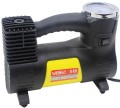Ways of connection to the power supply provided in the design of the compressor (see "Type").
—
Cigarette lighter. Connection to a standard cigarette lighter socket (or a separate auto socket of the same format). This method is convenient because the compressor does not need to open the hood. On the other hand, cigarette lighters have limits on maximum power, and in different cars (and even in different sockets of the same car), these limits can vary markedly. See Power Consumption for details.
—
Crocodiles. Connect directly to the battery terminals using crocodile clips. This method is somewhat more complicated than working from the cigarette lighter — you need to open the hood and pull the wires to the battery. On the other hand, it allows you to use the power of the on-board network to the fullest without worrying about overloads and the integrity of the fuses, making it suitable for even the most powerful and performant compressors. In addition, the “crocodiles” device can be connected not only to the on-board network, but also to a separate battery; in some cases, this possibility is useful (for example, if the car’s own battery is already running low, but there is a “fresh” battery nearby).
—
Cigarette lighter / "crocodiles". The ability to use any of the connection options described above is optional. This provides convenience and al
...lows you to choose the optimal format of work depending on the situation. For example, for quick pumping of one or two wheels, you can use the cigarette lighter, but for long-term work, food through the “crocodiles” is better suited.
— Fork. Plug for connecting to a regular 230 V socket (see "Power"). It is used in compressors having only this type of supply.
— Cigarette lighter / plug. Available on both 12V and 230 V models; for the first, a cigarette lighter is used, for the second, a plug.
— Cable (to the battery). Connection directly to the battery using cables with flat terminals, which are clamped into the battery terminals when connected. This design provides a tighter contact than the "crocodiles" described above, but is less convenient when connecting and disconnecting the compressor.Many pumps/compressors come in special
cases or cases that make them easy to store and transport. Under the cover, usually, we mean a classic cloth bag, which pumps are often equipped with and which rather protects them from dirt, dust, etc. But compressors are often supplied in plastic cases, they are convenient, inexpensive, rust-resistant and equipped with a convenient carrying handle . Plastic is considered less durable, but it is quite enough to provide the necessary protection.

